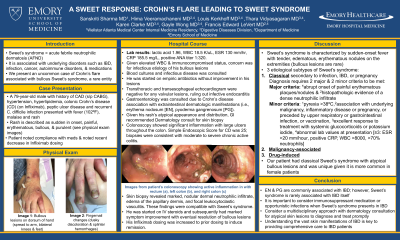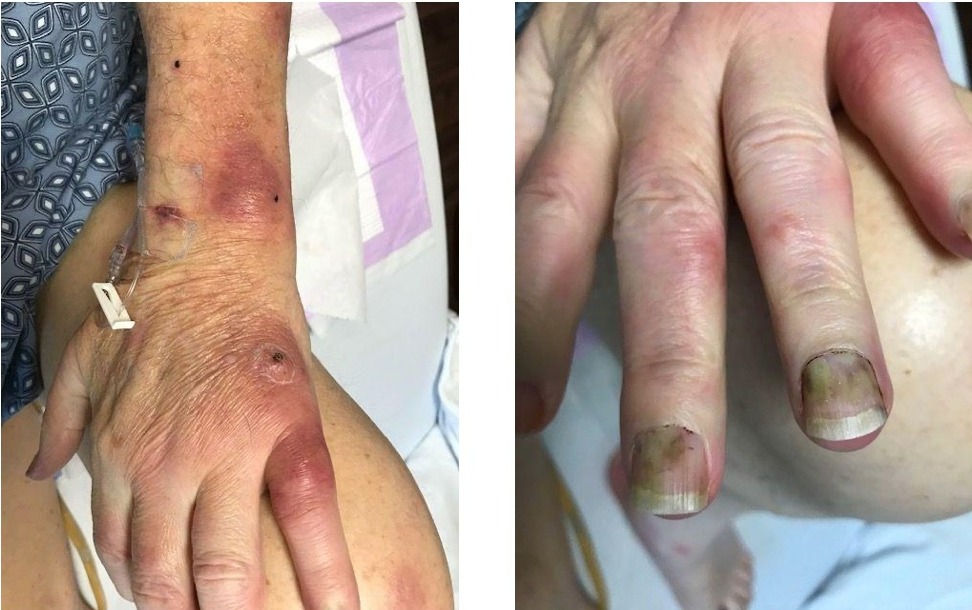Back


Poster Session D - Tuesday Morning
Category: IBD
D0417 - A Sweet Response: Crohn’s Flare Leading to Sweet Syndrome
Tuesday, October 25, 2022
10:00 AM – 12:00 PM ET
Location: Crown Ballroom

Has Audio

Hima Veeramachaneni, MD
Emory University School of Medicine
Atlanta, GA
Presenting Author(s)
Sanskriti Sharma, MD1, Hima Veeramachaneni, MD2, Edward LeVert, MD2
1WellStar Atlanta Medical Center, Atlanta, GA; 2Emory University School of Medicine, Atlanta, GA
Introduction: Sweet’s syndrome, or acute febrile neutrophilic dermatosis (AFND), is a rare extraintestinal manifestation of inflammatory bowel disease (IBD). It presents with fever, malaise, and erythematous papules that are tender, edematous, and, rarely, bullous. It is associated with underlying diseases including IBD, infections, cancer, autoimmune disorders, medications, and pregnancy.
Case Description/Methods: A 79-year-old male with colonic Crohn’s disease (on Infliximab), NSAID-related peptic ulcer disease, and recurrent Clostridium Difficile infection presented with sudden onset, exquisitely painful, bullous rash with fevers to 102oF. The blistering eruptions started on his left wrist and spread to his arms and legs, including extensor and flexor surfaces and soles of his feet. His laboratory results were significant for white blood cell count of 18.5 K/uL, erythrocyte sedimentation rate of 130 mm/hr, c-reactive protein of 185.5 mg/L, and positive ANA titer 1:320.
Gastroenterology was consulted for concern for IBD associated dermatological manifestation such as erythema nodosum (EN) or pyoderma gangrenosum (PG); however, given atypical appearance and distribution, dermatology consultation was recommended, and punch biopsy was obtained. Skin biopsy revealed nodular dermal neutrophilic infiltrate, consistent with Sweet’s syndrome. Given association with IBD, colonoscopy was performed revealing significant inflammation with large ulcers throughout the colon. Simple Endoscopic Score for Crohn’s disease was 25 with biopsies consistent with severe chronic active colitis. He was started on IV steroids with immediate improvement in pain and flattening of lesions. Ultimately, his infectious workup was negative, and it was concluded that his presentation was from severe Crohn’s flare.
Discussion: EN and PG are commonly associated with IBD; however, Sweet’s syndrome is rarely associated with IBD itself, and can also develop as a result of immunosuppressant medications or opportunistic infections. This case of Sweet’s syndrome was unique as it was secondary to uncontrolled IBD, the lesions were bullous, and the patient was male, as classically it is more common in females. It is prudent in patients with atypical appearance of skin lesions, to consider a multidisciplinary approach with dermatology consultation to diagnose and treat appropriately. Understanding the vast array of skin manifestations of IBD is key in providing comprehensive care to IBD patients.

Disclosures:
Sanskriti Sharma, MD1, Hima Veeramachaneni, MD2, Edward LeVert, MD2. D0417 - A Sweet Response: Crohn’s Flare Leading to Sweet Syndrome, ACG 2022 Annual Scientific Meeting Abstracts. Charlotte, NC: American College of Gastroenterology.
1WellStar Atlanta Medical Center, Atlanta, GA; 2Emory University School of Medicine, Atlanta, GA
Introduction: Sweet’s syndrome, or acute febrile neutrophilic dermatosis (AFND), is a rare extraintestinal manifestation of inflammatory bowel disease (IBD). It presents with fever, malaise, and erythematous papules that are tender, edematous, and, rarely, bullous. It is associated with underlying diseases including IBD, infections, cancer, autoimmune disorders, medications, and pregnancy.
Case Description/Methods: A 79-year-old male with colonic Crohn’s disease (on Infliximab), NSAID-related peptic ulcer disease, and recurrent Clostridium Difficile infection presented with sudden onset, exquisitely painful, bullous rash with fevers to 102oF. The blistering eruptions started on his left wrist and spread to his arms and legs, including extensor and flexor surfaces and soles of his feet. His laboratory results were significant for white blood cell count of 18.5 K/uL, erythrocyte sedimentation rate of 130 mm/hr, c-reactive protein of 185.5 mg/L, and positive ANA titer 1:320.
Gastroenterology was consulted for concern for IBD associated dermatological manifestation such as erythema nodosum (EN) or pyoderma gangrenosum (PG); however, given atypical appearance and distribution, dermatology consultation was recommended, and punch biopsy was obtained. Skin biopsy revealed nodular dermal neutrophilic infiltrate, consistent with Sweet’s syndrome. Given association with IBD, colonoscopy was performed revealing significant inflammation with large ulcers throughout the colon. Simple Endoscopic Score for Crohn’s disease was 25 with biopsies consistent with severe chronic active colitis. He was started on IV steroids with immediate improvement in pain and flattening of lesions. Ultimately, his infectious workup was negative, and it was concluded that his presentation was from severe Crohn’s flare.
Discussion: EN and PG are commonly associated with IBD; however, Sweet’s syndrome is rarely associated with IBD itself, and can also develop as a result of immunosuppressant medications or opportunistic infections. This case of Sweet’s syndrome was unique as it was secondary to uncontrolled IBD, the lesions were bullous, and the patient was male, as classically it is more common in females. It is prudent in patients with atypical appearance of skin lesions, to consider a multidisciplinary approach with dermatology consultation to diagnose and treat appropriately. Understanding the vast array of skin manifestations of IBD is key in providing comprehensive care to IBD patients.

Figure: A: Bullous lesions noted on patient's arm B: Fingernail changes
Disclosures:
Sanskriti Sharma indicated no relevant financial relationships.
Hima Veeramachaneni indicated no relevant financial relationships.
Edward LeVert indicated no relevant financial relationships.
Sanskriti Sharma, MD1, Hima Veeramachaneni, MD2, Edward LeVert, MD2. D0417 - A Sweet Response: Crohn’s Flare Leading to Sweet Syndrome, ACG 2022 Annual Scientific Meeting Abstracts. Charlotte, NC: American College of Gastroenterology.
